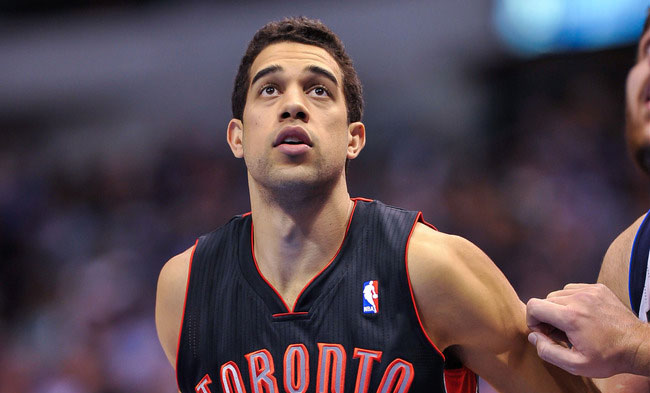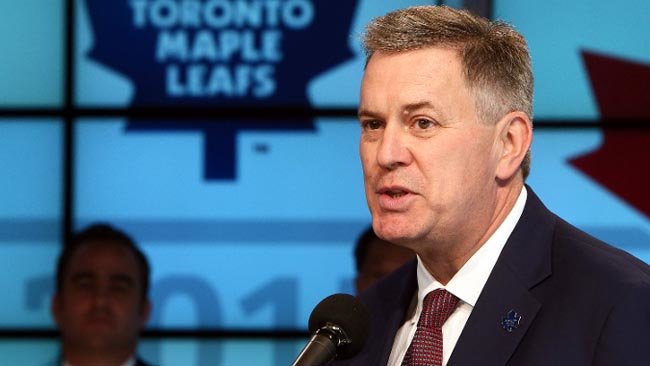The Raptors have a mid-level available and have two ways to spend that money: sign a backup big or sign a wing defender. Anyone choosing to spend it on a wing is very likely assuming that Landry Fields is a complete write-off in terms of on-court production. I would be inclined to say that that’s a tad bit on the hasty side except that evidence accumulated over the last two years firmly suggests that he’s about as useful as a screen door on a submarine.
Nobody’s quite expecting Landry Fields to start averaging 11 points on 50% of shooting as he did during his rookie season in New York. Upon joining the Raptors he played through injuries which forced him to alter his release, and by the time he got through his elbow and wrist surgeries, his shot-mechanics included a hitch which even he can’t tell is a problem or a desired motion in his release. From a three-point shooting standpoint, he’s a complete disaster. After shooting 39% in his rookie season, he went down to 26% the year after that (‘Melo effect had something to do with that), to 14% in his first season with the Raptors to 0% last year. That’s right – 0%. He missed all five of the threes he took in 30 games. The nil percentage isn’t as telling as the 5 attempts from downtown he attempted, which goes to show just how shot (get it?) his confidence is when it comes to the long ball. From a PER36 minute point of view, he’s gone from attempting 3.1 threes in his rookie year to 0.6 last season. That’s a man who does not want to shoot. From being a “3-and-D” man, he’s now become a “Maybe-some-D-when-healthy” man.
Despite his offensive failings there is redemption available for Fields, because as a long-armed 6’7″ wing, he’s an able defender who knows how to use his length to, if not disrupt, play the correct angles in one-on-one and team defense situations. His approach towards Joe Johnson in Game 2 in the Nets series was a perfect example of how he can influence a game defensively. He’s also a consistent team defender because he doesn’t gamble and sticks to his cover, which makes Dwane Casey’s aversion to using Fields even more perplexing. Perhaps Casey feels that Fields’ lack of three-point shooting garners such little respect on the offensive end that defenses can play off of him without fear of paying for it, which is an extreme stance but founded in some reality.
Accepting that Fields is a shooting void, there is a grassroots movement that believes that Fields is someone who can play off the ball and punish defenses with his movement. That, I find, is more fantasy than reality. Partially, it has to do with injury because other than wrist and elbow issues, Fields often suffers from back spasms which keep him nailed to the bench, and when he play, hamper his movement where he’s more of an idle bystander than an active participant in the offense. As a fan, it’s this backdoor-cutting, baseline screening, weak-side moving Fields that we’d like to see – at a bare minimum – on offense. If he’s unable to even do that, then he truly represents Marcus Camby-levels of dead salary.
Masai Ujiri and Dwane Casey have to, I would think, have a view on Fields that is more or less agreeable with this piece, because his lack of playing time (even in situations that warrant skill that he supposedly has) speaks volumes to just how little confidence management has in his abilities. He is on the roster because he remains an immovable contract. For a GM that was able to shift monumentally hideous contracts like Andrea Bargnani and Rudy Gay, it says something when Landry Fields remains on the roster. On a closer look, though, you could make a case that when it comes to value-for-money, Fields is worse than Bargnani or Gay, which is a feat on its own.
Fields is, depending on where you’re getting a numbers, likely to make $8.5M (Hoopshype) next year as part of the “poison pill” deal that Bryan Colangelo signed him to. It is very likely that he becomes a John Salmons-type asset at the deadline for a team looking to dump salary. Even the idea of playing him just to showcase him doesn’t hold water because the likelihood of him impressing a team to the point where his basketball value surpasses his contract value is very low. Until the deadline, the Raptors have to find some use for him and given the current making of the roster, Casey is forced to play him unless Bruno Caboclo or DeAnde Daniels find their way in front of him. The former will get a chance, the latter might not make it to training camp. Assuming his back is functional and that his shot remains a hot mess, this version of Landry Fields can still provide some sort of defense at the expense of offense. He’s essentially in line to be a slightly worse version of John Salmons on offense, but a slightly improved version of Salmons on defense.
The Raptors can still make use of Fields in a mix-and-match lineup which has enough shooting on the floor. For example, a lineup of Vasquez/Lowry, Williams/DeRozan, Patterson, Fields and Hayes/Nogueira has enough shooting from three positions on the court, allowing Fields to stay on the court. He could conceivably play 10-15 minutes in a structure similar to this while being used situationally, and sometimes hilariously like the time Dwane Casey used him for a total of 14 seconds in Game 7 in two stints of 7 seconds each. This sort of lineup is difficult to sustain if Fields continues to be a void on offense. Teams will catch on to what the Raptors are doing at which point the importance of Fields’ movement is magnified, and so far he hasn’t shown that he can consistently be the intelligent, off-the-ball player that he’s often drummed up to be.
The good news for Raptors fans is that Fields truly hasn’t been 100% at any point in his Raptors career. The bad news is that his wrist and elbow injuries might have decimated his shot, and his back injuries might have negated his defensive presence. The reality is that there’s no motivator in professional sports like the contract year, which is what Fields is coming upon. You have to hope that when given a chance – and he will get a chance – he’s able to contribute. Whether it be spelling DeRozan defensively against a tough cover, punishing teams for overplaying one of our guards, or out-rebounding his man on account of his length, he needs to do something.
The fear is that he possesses no discernible skill that will allow him to stay on the court, let alone make Dwane Casey think of creative ways to get him into the lineup. The hope is that his teammates do enough on offense allowing Fields to hide and become one of the better wing defenders on the team. There aren’t many instances of where this happens in the league, as defense-first players like Thabo Sefolosha, Trevor Ariza, Tony Allen etc., all have at least one thing they do well on offense. Fields, unfortunately, hasn’t been able to demonstrate this which makes it very difficult for Dwane Casey to plan for him, reducing him to what we saw last year: a very situational player.
I never begrudged Fields because you can’t blame a man for taking the money handed to him. I don’t even begrudge him for his tenure here, because he’s been marred by injury and has had his confidence shattered. Following him on Twitter, he’s a nice enough guy who, by all reports, is a hard worker and consummate professional. All one can do for Landry Fields is hope he pulls through, stays injury-free, and gets his offensive game going, both for the Raptors sakes and his long-term NBA career. At 26 years of age, he still has one shot to get it right. Let’s hope he takes it.




